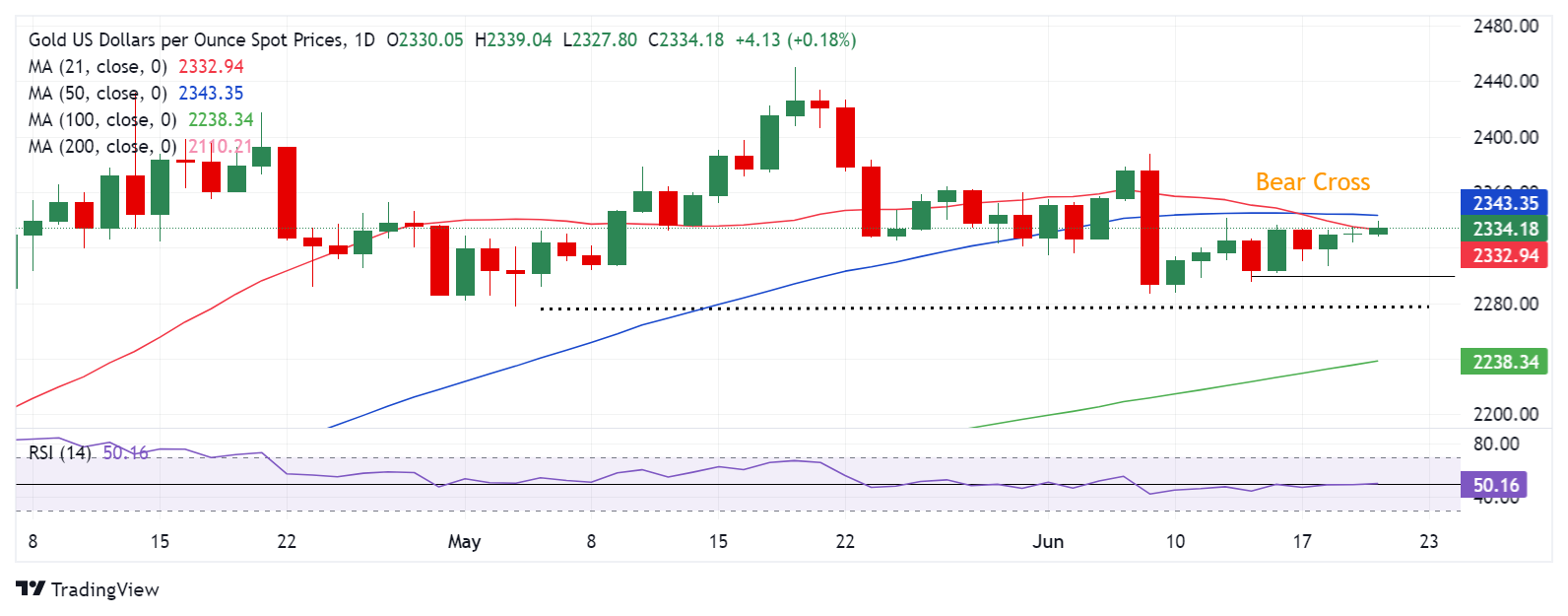- Gold price regains upside traction early Thursday after the Juneteenth holiday lull.
- The US Dollar pauses its decline as Treasury bond yields edge higher amid risk aversion.
- The daily RSI gradually moves above the midline, supporting the Gold price upside.
- All eyes stay on the US jobs and PMI data for fresh hints on the Fed’s rate-cut timing.
Gold price is finding fresh demand early Thursday, having witnessed a muted Wednesday because of the Juneteenth holiday in the United States (US).
Gold price awaits US data and Fedspeak for fresh policy cues
The US Dollar (USD) has paused its downside momentum, helped by a risk-averse market environment and a modest upswing in the US Treasury bond yields, underpinning the sentiment around the USD-denominated Gold price.
Investors seem to have turned cautious in the Asian trading hours after the People’s Bank of China (PBOC) left the key Loan Prime Rates unchanged, raising concerns over a lack of policy support to boost economic growth.
Further, markets also stay nervous, awaiting more clarity on the state of the US economy from Thursday’s weekly Jobless Claims and the preliminary business PMI reports on Friday, which will help traders gauge the timing of the US Federal Reserve’s (Fed) interest rate cut in the second half of this year.
The sentiment around the Fed rate-cut expectations will continue to dominate the US Dollar price action, eventually influencing the latest uptick in Gold price. Should risk aversion intensify in the upcoming sessions, investors will likely flock to the safe-haven US Dollar, limiting the Gold price upside.
However, if the US Jobless Claims and housing data disappoint and add to the renewed dovish Fed bets, fuelled by weaker-than-expected US Retail Sales data, the US Dollar could see a fresh selling interest, providing extra legs to the Gold price advance.
Gold price technical analysis: Daily chart
Gold price remains confined within a familiar range seen so far this week, with sellers refusing to give up yet.
Gold price faces stiff resistance around $2,340, the confluence zone of the 21-day Simple Moving Average (SMA) and the 50-day SMA. Meanwhile, the downside appears guarded by the $2,300 mark.
The 14-day Relative Strength Index (RSI) has risen slightly above the 50 level, suggesting that Gold buyers are giving a tough fight to the bearish interests.
Acceptance above the aforementioned key confluence support-turned-resistance near $2,340 is critical to sustaining the rebound toward the May 24 high of $2,364.
The next upside hurdle is seen at the June 7 high of $2,388.
However, a Bear Cross remains in play after the 21-day SMA crossed the 50-day SMA from above on a daily closing basis last Friday.
If sellers fight back control then the immediate support is seen at the $2,300 threshold, below which the June 10 low of $2,287 will be tested.
A sustained break below the latter will threaten the May 3 low of $2,277, as sellers aim for the $2,250 psychological barrier.
Gold FAQs
Gold has played a key role in human’s history as it has been widely used as a store of value and medium of exchange. Currently, apart from its shine and usage for jewelry, the precious metal is widely seen as a safe-haven asset, meaning that it is considered a good investment during turbulent times. Gold is also widely seen as a hedge against inflation and against depreciating currencies as it doesn’t rely on any specific issuer or government.
Central banks are the biggest Gold holders. In their aim to support their currencies in turbulent times, central banks tend to diversify their reserves and buy Gold to improve the perceived strength of the economy and the currency. High Gold reserves can be a source of trust for a country’s solvency. Central banks added 1,136 tonnes of Gold worth around $70 billion to their reserves in 2022, according to data from the World Gold Council. This is the highest yearly purchase since records began. Central banks from emerging economies such as China, India and Turkey are quickly increasing their Gold reserves.
Gold has an inverse correlation with the US Dollar and US Treasuries, which are both major reserve and safe-haven assets. When the Dollar depreciates, Gold tends to rise, enabling investors and central banks to diversify their assets in turbulent times. Gold is also inversely correlated with risk assets. A rally in the stock market tends to weaken Gold price, while sell-offs in riskier markets tend to favor the precious metal.
The price can move due to a wide range of factors. Geopolitical instability or fears of a deep recession can quickly make Gold price escalate due to its safe-haven status. As a yield-less asset, Gold tends to rise with lower interest rates, while higher cost of money usually weighs down on the yellow metal. Still, most moves depend on how the US Dollar (USD) behaves as the asset is priced in dollars (XAU/USD). A strong Dollar tends to keep the price of Gold controlled, whereas a weaker Dollar is likely to push Gold prices up.
Information on these pages contains forward-looking statements that involve risks and uncertainties. Markets and instruments profiled on this page are for informational purposes only and should not in any way come across as a recommendation to buy or sell in these assets. You should do your own thorough research before making any investment decisions. FXStreet does not in any way guarantee that this information is free from mistakes, errors, or material misstatements. It also does not guarantee that this information is of a timely nature. Investing in Open Markets involves a great deal of risk, including the loss of all or a portion of your investment, as well as emotional distress. All risks, losses and costs associated with investing, including total loss of principal, are your responsibility. The views and opinions expressed in this article are those of the authors and do not necessarily reflect the official policy or position of FXStreet nor its advertisers. The author will not be held responsible for information that is found at the end of links posted on this page.
If not otherwise explicitly mentioned in the body of the article, at the time of writing, the author has no position in any stock mentioned in this article and no business relationship with any company mentioned. The author has not received compensation for writing this article, other than from FXStreet.
FXStreet and the author do not provide personalized recommendations. The author makes no representations as to the accuracy, completeness, or suitability of this information. FXStreet and the author will not be liable for any errors, omissions or any losses, injuries or damages arising from this information and its display or use. Errors and omissions excepted.
The author and FXStreet are not registered investment advisors and nothing in this article is intended to be investment advice.
Recommended Content
Editors’ Picks

AUD/USD: Extra gains need to clear 0.6400
AUD/USD rose for the third day in a row, approaching the key 0.6400 resistance on the back of the acute pullback in the US Dollar amid mounting recession concerns and global trade war fear.

EUR/USD: Powell and the NFP will put the rally to the test
EUR/USD gathered extra steam and advanced to multi-month peaks near 1.1150, although the move fizzled out somewhat as the NA session drew to a close on Thursday.

Gold looks offered near $3,100
Prices of Gold remain on the defensive on Thursday, hovering around the $3,100 region per troy ounce and retreating from earlier all-time peaks near the $3,170 level, all against the backdrop of investors' assessment of "Liberation Day".

Interoperability protocol hyperlane reveals airdrop details
The team behind interoperability protocol Hyperlane shared their upcoming token airdrop plans happening at the end of the month. The airdrop will occur on April 22, and users can check their eligibility to receive $HYPER tokens via a portal provided by the Hyperlane Foundation by April 13, the team shared in a press release with CoinDesk.

Trump’s “Liberation Day” tariffs on the way
United States (US) President Donald Trump’s self-styled “Liberation Day” has finally arrived. After four straight failures to kick off Donald Trump’s “day one” tariffs that were supposed to be implemented when President Trump assumed office 72 days ago, Trump’s team is slated to finally unveil a sweeping, lopsided package of “reciprocal” tariffs.

The Best brokers to trade EUR/USD
SPONSORED Discover the top brokers for trading EUR/USD in 2025. Our list features brokers with competitive spreads, fast execution, and powerful platforms. Whether you're a beginner or an expert, find the right partner to navigate the dynamic Forex market.
